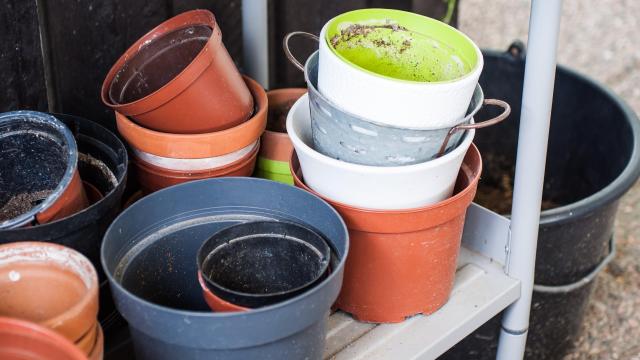As many houseplants and flowers mature, they outgrow the original pots and containers they called home and need to move into something bigger. And while reusing the pot is a great, sustainable option, it’s important to make sure that it’s cleaned thoroughly before moving a new plant in and having it set down roots. Here’s what to know about how — and why — to do that without hurting your plants.
Why you should clean flower pots before reusing them
Let’s say you had a flower pot that was full of dirt that you emptied along with the plant itself. It may seem pointless to put effort into cleaning the container if you’re going to turn around and all more dirt to it, but that’s not the case.
Regardless of whether the pot is made of clay, plastic, or another material, mineral deposits and other debris can accumulate in the pot over time and may harbour disease organisms, according to the Iowa State University Extension (ISUE). And if you don’t clean and disinfect the pots before you reuse them, they can harm their new occupant.
How to clean flower pots and containers
The amount of time and effort it takes to clean and disinfect flower pots and containers depends on their material and condition. Here are some guidelines:
How to clean unglazed clay pots (including terracotta)
One of the reasons why traditional terracotta pots are so popular with gardeners is because they’re porous — meaning that they allow air and water to pass through, which helps prevent the plant and its roots from rotting. But their porosity is also what makes them a little tricker to clean.
Start by removing any mineral deposits or other debris with steel wool or a wire-bristle brush, then giving the pots a quick rinse. Next, fill a container (like a bucket, plastic storage tote, etc) with one part white vinegar to four or five pots hot water, and a squeeze of mild liquid dish soap. Let the pots soak.
Fill a sink or other container with a mixture of one part white vinegar to four or five parts hot water, then add a squeeze of liquid dish soap. Soak the pots for at least an hour, but up to 24 hours, if necessary. Finally, rinse the pot to get it ready to sanitize (the instructions for that are below).
Glazed ceramic pots
The vinegar solution described above works for glazed ceramic pots, too, but this time, skip the steel wool and wire brush. Instead, scrub away stubborn mineral deposits with a paste made of three parts baking soda to one part water, then rinse and sanitize.
Plastic pots
Either of methods above work for plastic pots. Or, if they’re not in bad shape, you can wash it using a sponge, hot water, and dish soap. As always, rinse and then disinfect.
How to disinfect flower pots and containers
Once the pots are clean, it’s time to disinfect them. According to the ISUE, the same disinfecting method works for any pot or container, regardless of what it’s made from. Here’s what to do:
- Thoroughly rinse the pot before you start sanitizing — especially if you used vinegar. We’re about to use bleach, and combining it with vinegar can produce dangerous chlorine gas.
- Fill a large container (or utility sink) with a solution of 10 parts water to one part bleach.
- Fully submerge the pot in the solution and let it soak for 30 minutes.
- Thoroughly rinse them again before using.
- Set the cleaned and sanitised pots in the sun to dry (without stacking them).
It’s also possible to sanitize glazed ceramic and plastic pots by running them through the dishwasher.

Leave a Reply
You must be logged in to post a comment.